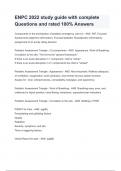ENPC 2022 study guide with complete
Questions and rated 100% Answers
Components in the prioritization of pediatric emergency care (4) - ANS PAT, Focused
Assessment (objective information), Focused pediatric Hx(subjective information),
assignment of an acuity rating decision
Pediatric Assessment Triangle : (3) components - ANS Appearance. Work of Breathing.
Circulation to the skin. This forms the "general impression".
If there is an acute disruption in 1 component, child is "sicker".
If there is an acute disruption in 2+ components the child is "sickest"
Pediatric Assessment Triangle : Appearance - ANS Most important. Reflects adequacy
of ventilation, oxygenation, brain perfusion, and central nervous system function.
Assess for : tone, interactiveness, consolability, look/gaze, and speech/cry.
Pediatric Assessment Triangle : Work of Breathing - ANS Breathing easy, even, and
unlabored or tripod position, nasal flaring, retractions, supraclavicular retractions
Pediatric Assessment Triangle : Circulation to the skin - ANS Mottling or PWD
PQRST for Pain - ANS (pg86)
Precipitating and palliating factors
Quality
Radiation
Severity, symptoms, and site
Time or triggering factors
Verbal Report for pain - ANS (pg86)
,Self-report is the most reliable indicatior of pain; however not all pediatric pt are capable
or wiling to verbalize their discomfort.
What age is the respiratory system considered fully developed? - ANS 8 years old
Most ______ age __to____, are concrete thinkers and interpret words literally.
Where as, most _____ age ___ to ___, are magical and illogical thinkers. They often
confuse coincidence with causation, and have difficulty distinguising fantasy from reality.
- ANS (pg36)
Most Toddlers age 1yo to 3yo , are concrete thinkers and interpret words literally.
Where as, most Preschoolers age 3yo to 5yo, are magical and illogical thinkers. They
often confuse coincidence with causation, and have difficulty distinguising fantasy from
reality.
Hypotension related to hypovolemia in pediatric trauma patients is a _____ sign and
may indicate a loss of ___% to ___% of their circulating blood volume. - ANS (pg262)
Late sign.
20% to 25% of circulating blood volume
6P's Assessment for Musculoskeletal Trauma - ANS (pg 283)
Pallor : color different from uninjured
Pain
Pulselessness
Parasthesia
Paralysis
Poikilothermia
Burn Transfer Criteria - ANS 1. Partial thickness >10% of BSA
2. Face, hands, feet, genetalia, perineum or major joints
3. Third degree burns in any age group.
4. Electrical burns, including lightning injury, and chemical burns.
, 5. Inhalation injury.
6. Burn injury in pt with preexisting medical disorders that could complicate tx.
7. Concomitant trauma (such as fx) in which the burn injury poses the greatest risk of
morbidity or mortality.
8. Burned children in hospital wo qualified equipment or personnel to care for them
9. Pt who will require special social, emotional, or rehabilitative intervention.
If live interpreter not available for 15mins use ________ - ANS Language line
interpreter
Infants are obligate nose breathers. If nose is obstructed ___________ - ANS suction
nose
Opiod antidote - ANS Narcan
Benzo antidote - ANS Romazicon
Neutropenic pt with a temperature - ANS Don't take rectal temp.
No invasive procedures if not necessary.
Nonblanchable Rashes of concern - ANS Meningocoxcemia
Petiachia/Purpura
Bicycle accident concerns - ANS Did pt strike handle bars?
Possible abdominal injury
Ribs are more horizontal and provide less protection.
Normal Urine Output for child - ANS 1 to 2ml / Kg / Hr
Differences of child vs adult : BSA, blood volume, glycogen storage, metabolic rate -
ANS Children have : increased BSA(predispose to temp dysregulation), decreased




